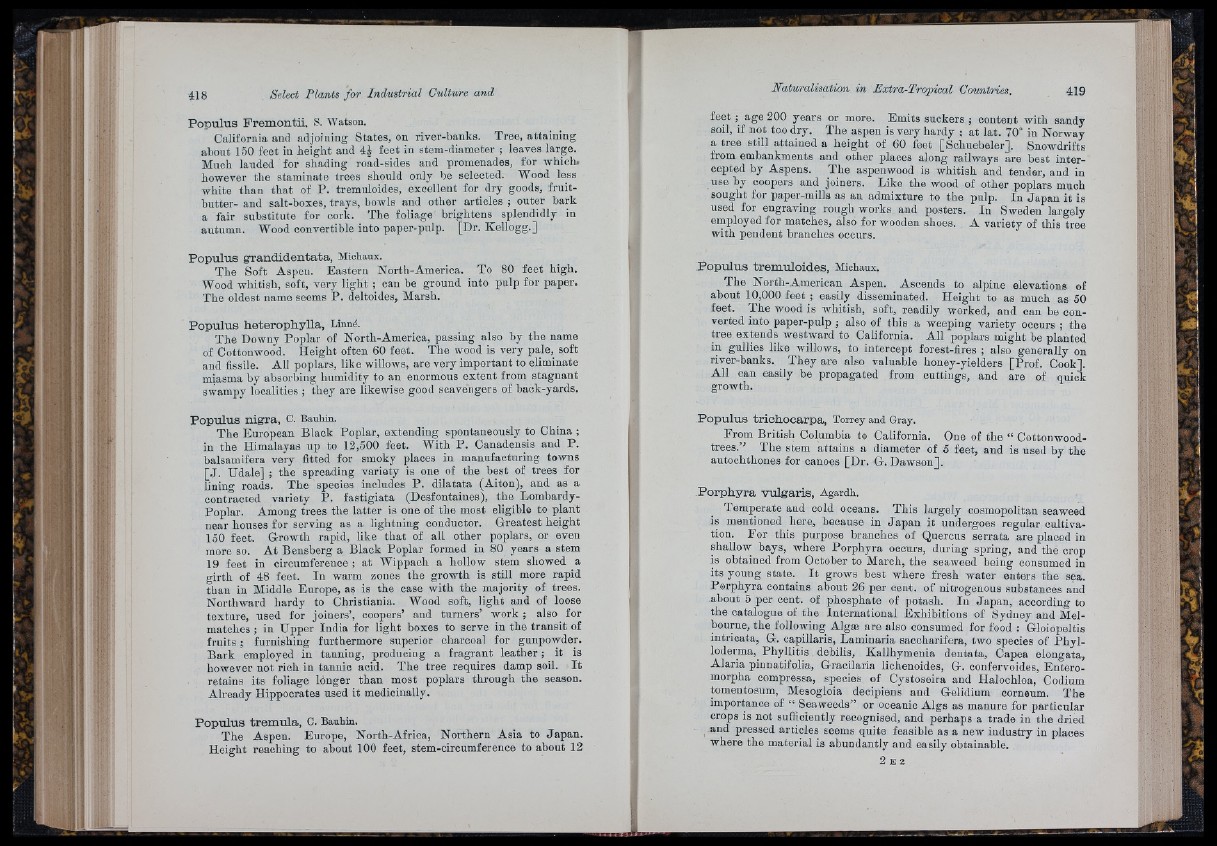
P o p u lu s P r em o n ti i , S. Watson.
California and adjoining States, on river-banks. Tree, attaining
about 150 feet in height and 4J feet in stem-diameter ; leaves large.
Much lauded for shading road-sides and promenades, for which,
however the staminate trees should only be selected. Wood less
white than that of P . tremuloides, excellent for^ dry goods, fruit-
butter- and salt-boxes, trays, bowls and otlier articles ; outer bark
a fair substitute for cork. The foliage brightens splendidly in
autumn. Wood convertible into paper-pulp. [Dr. Kellogg.]
P o p u lu s g r a n d id e n t a t a , Michaux.
The Soft Aspeii. Eastern North-America. To 80 feet high.
Wood whitish, soft, very light ; can be ground into pulp for paper.
The oldest name seems P . deltoides. Marsh.
P o p u lu s h e te r o p h y ll a , Linné.
The Downy Poplar of North-America, passing also by the name
of Cottonwood. Height often 60 feet. The wood is very pale, soft
and fissile. All poplars, like willows, are very important to eliminate
miasma by absorbing humidity to an enormous extent from stagnant
swampy localities ; they are likewise good scavengers of back-yards.
P o p u lu s n ig r a , C. Bauhin.
The European Black Poplar, extending spontaneously to China ;
in the Himalayas up to 12,500 feet. With P. Canadensis and P.
balsamifera very fitted for smoky places in manufacturing towns
'J . Udale] ; the spreading variety is one of the best of trees for
iniug roads. The species includes P . dilatata (Aiton), and as a
contracted variety P. fastigiata (Desfontaines¥ the Lombardy-
Poplar. Among trees tlie latter is one of the most eligible to plant
near houses for serving as a lightning conductor. Greatest height
150 feet. Growth rapid, like that of all other poplars, or even
more so. At Bensberg a Black Poplar formed in 80 years a stem
19 feet in circumference ; at Wippach a hollow stem showed a
girth of 48 feet. In warm zones the growth is still more rapid
than in Middle Europe, as is the ease with the majority of trees.
Northward hardy to Christiania. Wood soft, light and of loose
texture, used for joiners’, coopers’ and turners’ work ; also for
matches ; in Upper India for light boxes to serve in the transit of
fruits ; furnishing furthermore superior charcoal for gunpowder.
Bark employed in tanning, producing a fragrant leather ; it is
however not rich in tannic acid. The tree requires damp soil. I t
retains its foliage longer than most poplars through the season.
Already Hippocrates used it medicinally.
P o p u lu s t r ém u l a , 0. Bauhin.
The Aspen. Europe, North-Africa, Northern Asia to Japan.
Height reaching to about lOO feet, stem-circumference to about 12
fe ri ; age 200 years or more. Emits suckers ; content with sandy
soil, if not too dry. The aspen is very hardy : at lat. 70° in Norway
a tree still attained a height of 60 feet [Schuebeler]. Snowdrifts
from embankments and other places along railways are best intercepted
by Aspens. The aspenwood is whitish and tender, and in
use by coopers and joiners. Like the wood of other poplars much
sought for paper-mills as an admixture to the pulp. In Japan it is
used for engraving rough works aud posters. In Sweden largely
ernployed for matches, also for wooden shoes. A variety of this tree
with pendent branches occurs.
P o p u l u s tr em u lo id e s , Michaux.
The North-American Aspen. Ascends to alpine elevations of
about 10,000 feet ; easily disseminated. Height to as much as 50
feet. The wood is whitish, soft, readily worked, and can be converted
into paper-pulp ; also of this a weeping variety occurs ; the
tree extends westward to California. All poplars might be planted
in gullies like willows, to intercept forest-fires ; also generally on
river-banks. ^ They are also valuable honey-yielders [Pro f. Cook].
All can easily be propagated from cuttings, and are of quick
growth.
P o p u l u s t r ic h o c a r p a , Torrey and Gray.
From British Columbia to California. One of the “ Cottonwood-
trees.” The stem attains a diameter of 5 feet, and is used by the
autochthones for canoes [Dr. G. Dawson].
P o r p h y r a v u lg a r i s , Agardh.
Temperate and cold oceans. This largely cosmopolitan seaweed
is mentioned here, because iu Jap an it undergoes regular cultivation.
For this purpose branches of Quercus serrata are placed in
shallow bays, where Porphyra occurs, during spring, and the crop
is obtained from October to March, the seaweed being consumed iu
its young state. I t grows best where fresh water enters the sea.
Porphyra contains about 26 per cent, of nitrogenous .substances and
about 5 per cent, of phosphate of potash. In Japan, according to
the catalogue of the International Exhibitions of Sydney and Melbourne,
the following Algse are also consumed for food : Gloiopeltis
intricata, G. capillaris, Laminaria saccharifera, two species of Pbyl-
loderma,^ Phyllitis debilis, Kallhymenia dentata, Capea elongata,
Alaria pinnatifolia, Gracilaria lichenoides, G. confervoides, Entero-
morpha compressa, species of Cystoseira and Halochloa, Codium
tomentosum, Mesogloia decipiens and Gelidium corneum. The
importance of “ Seaweeds” or oceanic Algs as manure for particular
crops is not sufficiently recognised, and perhaps a trade in the dried
and pressed articles seems quite feasible as a new industry in places
where the material is abundantly and easily obtainable.